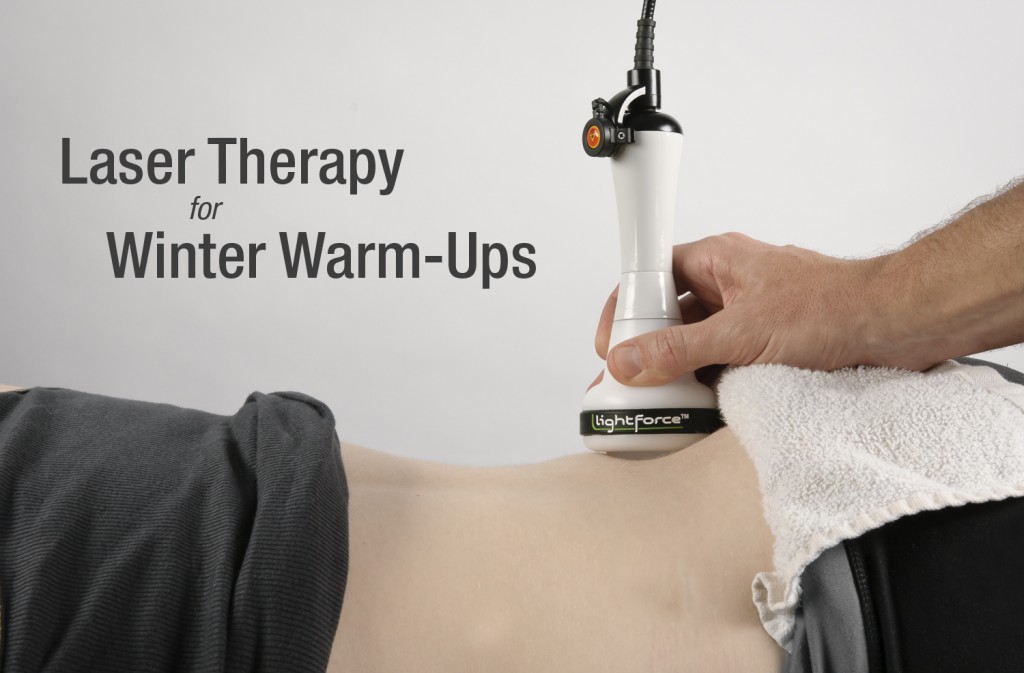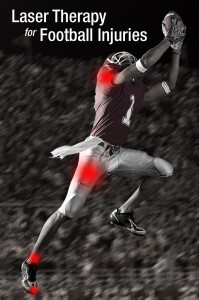Learn tips about Class IV laser therapy and other health related topics on the LightForce Therapy Lasers blog! Check back weekly for updated posts.
Guest Blog by Dr. Perry Nickelston DC, NKT, FMS, SFMA
Before you lace up your shoes and put on your sweats this season, take a minute to consider using deep tissue laser therapy as a warm-up tool. Here are 4 ways adding laser therapy to your warm-up program can help better prepare your body for physical activity.

1. Increasing Blood Flow
One of the main goals of warm-up exercises is to help increase blood flow, bringing vital nutrients to muscles. Stretching and isometrics can accomplish this goal, but their effectiveness can be diminished for areas with damaged tissue. Laser therapy is a great option for safely increasing blood flow, particularly in damaged tissue, due to its vasodilatory effects. The laser light helps to produce nitric oxide, a powerful vasodilator and important cellular signaling molecule involved in many physiological processes. Just a few minutes of laser therapy prior to stretching may increase the effectiveness of your warm-up and decrease the amount of warm-up time.
2. Increasing Muscle Temperature
A primary goal of warming up is to increase muscle temperature. Movement on its own helps to facilitate this effect, but adding Class IV laser therapy can give you an edge when trying to gradually warm tissue. Class IV laser therapy treatments create a gentle, soothing warmth, as substances like water and hemoglobin absorb some of the energy. Applying laser therapy during warm-up patterns is a win-win combination.
3. Increasing Range of Motion
Increasing range of motion by limbering the body and improving mobility is an additional goal of warm-up exercises. While range of motion can be improved though stretching and other warm-up activities, it can be further improved by decreasing any underlying inflammation. Inflammation causes pain, which will restrict motion since the body will fall back on self-preservation and protection.
Many athletes (and non-athletes) have a general amount of inflammation present at any given time — inflammation that occurs from tissue breakdown with athletic activities and training. This inflammation can inhibit range of motion and put people at greater risk for injury if it is not addressed prior to activity. Laser therapy helps to reduce inflammation, which leads to an improved range of motion that warming up alone can typically not achieve.
4. Getting to Hard-to-Reach Areas
Deep-structure muscles and joints can also be difficult to adequately prepare for activity with standard warm-ups. Reaching deep muscles such as the psoas with manual manipulation or stretches is challenging and often painful. Tight hips are a common problem in sports and using laser therapy on the hip joints prepares the core for optimal power and performance. Class IV laser therapy is particularly well-suited for not only reaching these deeper structures, but for also delivering an appropriate therapeutic dose to these target areas. Class IV lasers are more powerful than low level lasers (for a more detailed explanation of the role power plays, please watch this free on-demand webinar). This deep-tissue higher-power delivery can be even further enhanced by using a massage-ball head to compress shallow structure and disperse superficial fluids – and who doesn’t like the idea of a laser massage?
Warming Up to Laser Therapy
In addition to your favorite workout sneaks, you should consider adding laser therapy to your warm-up routines. Over 50 professional sports teams in the United States already have LightForce Therapy Lasers in their training rooms – maybe it’s time to add one to yours!
Guest Blog by Dr. Perry Nickelston

Football players experience a high number of musculoskeletal injuries throughout the season. Treatment methods may vary depending on the injury, but one modality that is increasingly gaining favor with professional and collegiate football teams for treatment of musculoskeletal injuries is Class IV Laser Therapy.
Here are some common football-related injuries that get great results with laser therapy to help get athletes (amateur, collegiate, and pro alike) back out on the field faster:
Ankle Sprain/Strain
Laser therapy is effective for fast reduction of inflammation associated with this common injury. The use of lasers for pain reduction is becoming a standard of care in football training rooms across the country. Acute ankle sprains are painful in large part due to the amount of inflammation, so the sooner you can apply the laser after injury, the better.
Treatment Recommendation: Treat 1-2 times daily for three days with roughly 5 J/cm2 at 6-7 W (for a total of 1000 J). Then treat every other day for 3-6 sessions, with 8-10 J/cm2 at 9-10 W (for a total of 2,000 J), expanding treatment area around the ankle.*
Torn Hamstrings
High hamstring injuries are prevalent in this sport — occurring most often when an athlete is running. When the muscle tears, immediate pain and eventual bruising occur. Laser therapy helps stimulate torn tissue and reduces the amount of bruising.
Treatment Recommendation: Treat 1-2 times daily for three days with 6-7 J/cm2 at 8-9 W (for a total of
2,500 J). Then treat daily for 4 sessions with 8-10 J/cm2 at 12 W (for a total of 3,500 J). Finally, treat every other day for 3 sessions with the same dose.
Shoulder Tendinitis
Repetitive slow-onset injuries such as tendinitis respond well to laser therapy. Inflammation and swelling in the tendon cause sharp pain with movement, eventually leading to disuse. Laser therapy helps reduce pain, allowing for more movement and faster recovery.
Treatment Recommendation: Go for a total of 6-10 sessions with 8-10 J/cm2 at 8-10 W (for a total of 3000 J). Treat daily for first 3 days, then every other day for 3- 6 sessions.
Turf Toe
Toe injuries are difficult to recover from because every standing movement affects the joint. Turf toe is notorious for being painful and stubborn to treat. Laser therapy applied to the toe increases blood circulation and joint range of motion, helping increase pain-free movement.
Treatment Recommendation:
- Direct treatment on the toe: 200 J at 4-5 W, for a total of 6 treatments. Treat twice a day for the first three days, then every other day.
- Treatment on the muscles of the big toe: 1,000 J for flexor, 1,000 J for extensor, and 1,000 J for the bottom of the foot, all at 9-10 W. Treat twice a day for the first three days, then every other day.
Meniscus Injury (Medial and Lateral)
Knee injuries can be career ending. They are extremely painful and debilitating — I know because I’ve had one. Reducing swelling and inflammation is paramount to ensure the knee does not lock. Deep Tissue Laser Therapy delivers therapeutic light energy to the inner knee, helping to reduce pain and swelling.
Treatment Recommendation: Treat meniscus directly 1-2 times daily for 3 days, with 6-7 J/cm2 at 9-10 W (for a total of 700 J). Then treat both the meniscus and surrounding areas every other day with 8-10 J/cm2 at 9-10 W for 4-6 sessions (1,000 J over meniscus and another 2,000 J in knee, calf and thigh).*
*MVP Tip: One of the benefits of using higher-powered Class IV laser therapy is being able to treat surrounding areas quickly and effectively, promoting more comprehensive recovery.
If you’re looking for a new way to tackle pain and inflammation related to many common injuries, you may want to consider adding laser therapy equipment to your line-up.
Top 10 Countdown supporting the addition of Deep Tissue Laser Therapy.
10. Get FAST Results: Reduction of pain and inflammation begins as soon as the laser light enters the body, so relief often begins with the first treatment. High power kicks off these processes more efficiently and effectively – a real winner for those suffering from chronic pain.
9. Treat Larger Areas: Expand your area of interest and don’t spend all day treating. With more power, treating large body areas can be easy without compromising dose.
8. Treat Multiple Areas: Managing referred pain can be a challenge. Not only treat larger areas, but also treat in multiple locations around the body. Go beyond that of low-level laser and treat multiple referring pain sites and get a better outcome!
7. Achieve Chronic Pain Relief: Bumping up the power density can get you results in the most challenging patient. Where other methods have failed, treat deep into tissue and make a difference with chronic pain.
6. Increase Compliance: Deep Tissue Laser Therapy is now faster than ever. Add a fast, effective treatment that will make a difference in outcomes. Set goals high and drive compliance with this unique technology.
5. Feel the Difference: Patients feel the difference immediately. They get more of the soothing warmth that they enjoy, and when they get off the table they feel great because they know it did something – they felt it.
4. Experience Versatility: It’s not all about treating everything with 25 Watts – so use the power when you need it, or turn it down for more acute or superficial conditions. You have the “power” to decide and the laser you need to optimize every treatment.
3. Deliver Higher Dosages: Some cases just require you to bring out the “big guns.” Some patients are in really poor shape and are experiencing excruciating pain. With these cases, the trend has been to treat with higher doses. With higher-power lasers, you can deliver higher doses in a short period of time and still know that there are limited risks of overtreating.
2. Increase Practice Traffic: Referrals are typically a huge source for new patients. High-power laser allows you to maximize each visit and realize better outcomes. Patients are happy and impressed with their experience. They are far more inclined to recommend you.
1. Get the “Wow” Factor: Experience the “homerun” outcome more frequently. Deep Tissue Laser Therapy has the power to make believers of everyone…patients and practitioners included. “Wow!”



